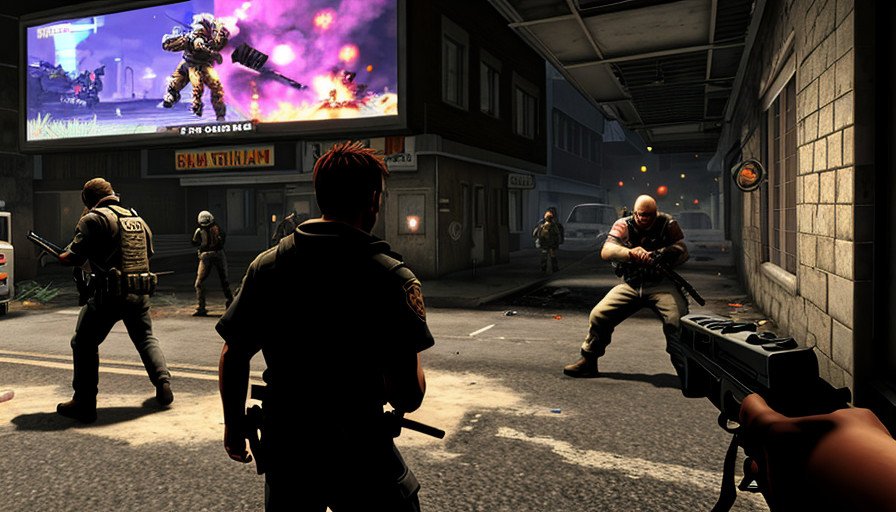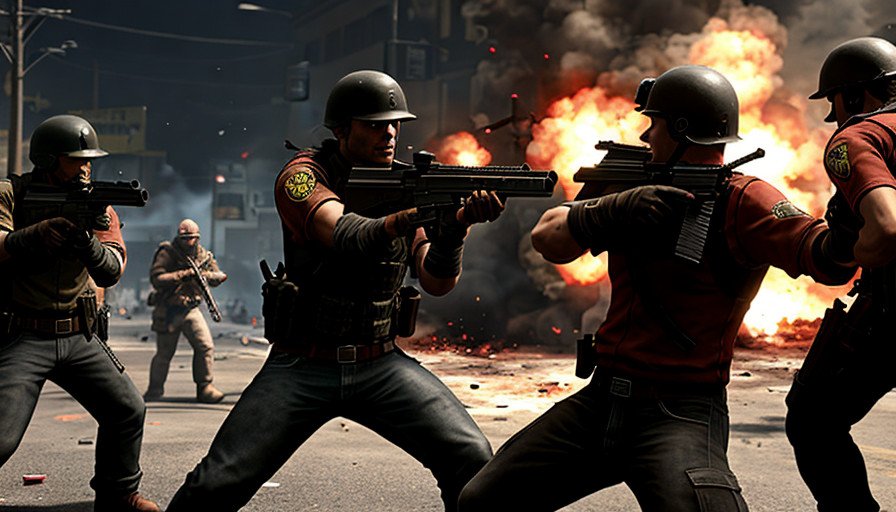Definition of Video Game Violence
Video game violence refers to the depiction of graphic, often brutal and bloody, acts of aggression in video games. These acts range from simple fist fights to complex, strategic battles involving firearms and explosives. The violence in video games often involves the player directly engaging in these acts, either as a participant in the game or as an observer of the game’s events.
Brief Overview of the Controversy Surrounding the Impact of Violent Video Games on Behavior
The impact of violent video games on behavior has been a subject of intense debate and controversy. Advocates for stricter regulations on video games often point to several high-profile incidents of violence, such as school shootings, and argue that these acts were influenced by violent video games.
However, the scientific community is divided on this issue, with some studies suggesting a link between video game violence and real-world aggression, while others find no such connection.
The controversy surrounding video game violence is not new. As early as the 1980s, the United States Surgeon General, C. Everett Koop, raised concerns about the potential connection between video games and youth behavior.
In 1982, Koop stated, “more and more people are beginning to understand the connection between video games and mental and physical health effects on youth.” However, he also noted that at that time, there was not sufficient evidence to make any conclusions.
The controversy escalated in the late 1990s and early 2000s, following the Columbine High School massacre in 1999 and the Winnenden school shooting in 2009. In both cases, the perpetrators were found to be avid players of violent video games.
These incidents led to widespread public concern and calls for stricter regulations on the sale and marketing of violent video games to minors.

Despite these high-profile incidents, the scientific consensus on the impact of violent video games on behavior remains inconclusive. Some studies have found a link between video game violence and aggressive behavior, while others have not.
Furthermore, the relationship between video game violence and real-world violence is complex and multifaceted, involving numerous factors beyond the content of the games themselves.
The history of video game violence is marked by a complex interplay of technological innovation, societal concerns, and scientific debate. As the video game industry continues to evolve, so too will the ongoing discussion about the impact of video game violence on behavior.
II. Early History of Video Game Violence
A. Pioneering video games with violent themes
B. Initial public and regulatory responses to violent video games
A. Pioneering Video Games with Violent Themes
The history of video game violence dates back to the early days of the industry. One of the first instances of violent video games was the game “Death Race” developed by Exidy in 1976. In this game, players had to run over pedestrians to score points.
Despite the controversy surrounding the game, it was a commercial success, with 900 units sold by 1977. The game was seen as a precursor to the more graphic and violent video games that would become popular in the following decades.
In the 1980s and 1990s, the popularity of violent video games grew with the release of games like “Street Fighter II” and “Mortal Kombat”. These games depicted graphic violence and were often criticized for their content.
In response to these games, Sega created the Videogame Rating Council in 1993 to provide descriptive labeling for every game sold on a Sega home console. This council later gave rise to the industry-wide Entertainment Software Rating Board, which is still used today to rate video games based on content.
B. Initial Public and Regulatory Responses to Violent Video Games
The public and regulatory responses to violent video games have varied over time. In the 1970s, the United States Surgeon General, C. Everett Koop, was one of the first to raise concerns about the potential connection between video games and youth behavior. However, at that time, there was not sufficient evidence to make any conclusions.
In the late 1990s and early 2000s, following high-profile incidents of violence such as the Columbine High School massacre in 1999 and the Winnenden school shooting in 2009, there was a significant increase in public concern and calls for stricter regulations on the sale and marketing of violent video games to minors.
In response to these incidents, several countries and states introduced legislation to regulate the sale of violent video games. However, the effectiveness of these regulations in reducing violence remains a subject of debate.
Despite the controversy surrounding violent video games, the industry has continued to evolve and adapt. Many game developers have started to incorporate more mature and complex narratives into their games, exploring themes of violence and aggression in a more nuanced and contextualized manner.
This shift towards more realistic and immersive gameplay has allowed players to engage with violent content in a more thoughtful and considered manner.
III. Evolution of Video Game Violence
A. Technological advancements and their impact on the portrayal of violence in video games
B. The emergence of rating systems and their effectiveness in regulating access to violent content
A. Technological Advancements and Their Impact on the Portrayal of Violence in Video Games
Technological advancements have played a significant role in shaping the portrayal of violence in video games. As technology has evolved, video games have become more immersive and realistic, allowing players to experience violence in a more visceral and emotionally impactful way.
For instance, the advent of 3D graphics in the late 1990s allowed game developers to create more lifelike and detailed depictions of violence. This led to an increase in graphic violence in video games, with games like “Doom” and “Grand Theft Auto” becoming notorious for their brutal content.

The introduction of virtual reality (VR) technology has further enhanced the realism of video game violence. VR games can provide players with a highly immersive experience, making them feel as if they are directly participating in the violent events depicted in the game. This can make the violence in these games feel more intense and impactful, potentially influencing the player’s behavior nc.
However, it’s important to note that the use of VR technology for violent games is not without controversy. Some critics argue that the immersive nature of VR games can make the violence in these games more disturbing and potentially harmful to players.
B. The Emergence of Rating Systems and Their Effectiveness in Regulating Access to Violent Content
In response to the controversy surrounding violent video games, the video game industry has developed rating systems to help parents and consumers make informed decisions about which games to buy. The Entertainment Software Rating Board (ESRB) was established in 1994 and provides ratings for video games based on factors such as violence, sex, and language.
The ESRB ratings have been effective in regulating the sale of violent video games to minors. By requiring retailers to display these ratings, the ESRB has made it easier for parents to identify violent games and make informed purchasing decisions.
However, the effectiveness of rating systems in reducing violence has been a subject of debate. Critics argue that these systems do not go far enough in preventing children from accessing violent games, while proponents argue that they are an important tool in helping parents make informed decisions about their children’s gaming habits.
The evolution of video game violence has been shaped by a complex interplay of technological advancements, societal concerns, and regulatory responses. As the video game industry continues to innovate, it will be crucial to continue these discussions and develop effective strategies for regulating the portrayal of violence in video games.
IV. Research and Studies
A. Overview of key studies on the effects of violent video games on behavior
B. Controversies and debates surrounding the findings of these studies
A. Overview of Key Studies on the Effects of Violent Video Games on Behavior
Several studies have been conducted to explore the potential impact of violent video games on behavior. Some of these studies have found a correlation between violent video game playing and aggressive behavior, while others have not.
For instance, a study conducted by Szymon Zbigniew Olejarnik and Daniela Romano found that violent video games were linked to verbal aggression and hostility, but not physical aggression. The researchers noted that the choice of violent video games did not significantly impact the relationship between personality traits and aggression. They also found that the motivation to play games where players take on roles such as thieves or killers was associated with higher levels of aggression.

Another study found that violent video games can initiate adolescents’ observational learning, which can change their understanding and acceptability of aggression. This study suggested that normative beliefs about aggression can mediate the relationship between violent video games and adolescent aggression .
However, it’s important to note that these studies do not establish a causal relationship between violent video games and aggressive behavior. They suggest that violent video games may be associated with aggressive behavior, but there could be other factors at play that truly cause these behaviors to arise.
B. Controversies and Debates Surrounding the Findings of These Studies
The findings of these studies have sparked debates and controversies. Some critics argue that the evidence linking violent video games to aggressive behavior is not strong enough to establish a causal relationship. They point out that many other factors can influence aggressive behavior, such as personality traits, social environment, and mental health conditions.
On the other hand, proponents of the link between violent video games and aggressive behavior argue that the studies provide important evidence of a potential risk. They suggest that violent video games can desensitize players to real-life violence and contribute to aggressive behavior.
There is also a debate about the role of video games in society. Some critics argue that violent video games are a convenient scapegoat for those who would rather not deal with the actual causes of violence. They suggest that the focus on video games diverts attention from more pressing issues, such as mental health, education, and social policies.
In conclusion, the research on the effects of violent video games on behavior is complex and multifaceted. While some studies suggest a potential link between violent video games and aggressive behavior, others do not. The ongoing debate about this issue underscores the need for further research and a more nuanced understanding of the relationship between video games and behavior.
V. Societal Impact
A. Influence of violent video games on youth and adolescents
B. Legal and regulatory responses to concerns about video game violence
A. Influence of Violent Video Games on Youth and Adolescents
Violent video games have been found to have a significant influence on the behavior of youth and adolescents. According to Bandura’s social cognitive theory, violent video games can initiate adolescents’ observational learning, where they can imitate the aggressive behavior of the model and change their understanding and acceptability about aggression.
Studies have shown that normative beliefs about aggression are directly related to aggression. First, self-reported aggression is significantly correlated to normative beliefs about aggression. General normative beliefs about aggression can predict young people’s physical, verbal, and indirect aggression. Retaliatory normative beliefs about aggression can anticipate adolescent retaliation behavior after 1 year .
The family environment can also play a significant role in moderating the effects of violent video games on adolescents. For individuals with a good family environment, exposure to violent video games only has a direct effect on aggression. However, for those with a poor family environment, there is an indirect effect mediated by normative beliefs about aggression alongside a direct effect.
B. Legal and Regulatory Responses to Concerns About Video Game Violence
In response to concerns about the impact of violent video games on behavior, several legal and regulatory measures have been implemented. For instance, the United States Congress passed the Violence in Video Games Act in 2000, which required the video game industry to implement a rating system for games based on their content.

The Entertainment Software Rating Board (ESRB) was established in 1994 to provide ratings for video games based on factors such as violence, sex, and language. The ESRB ratings have been effective in regulating the sale of violent video games to minors, making it easier for parents to identify violent games and make informed purchasing decisions.
However, the effectiveness of these regulations in reducing violence has been a subject of debate. Critics argue that these systems do not go far enough in preventing children from accessing violent games, while proponents argue that they are an important tool in helping parents make informed decisions about their children’s gaming habits.
In conclusion, the societal impact of video game violence is a complex issue that involves a variety of factors, including the content of the games, the behavior of the players, and the regulatory measures in place to control the sale and marketing of violent video games.
As the video game industry continues to evolve, it will be crucial to continue these discussions and develop effective strategies for managing the societal impact of video game violence.
VI. Industry and Cultural Perspectives
A. Perspectives from video game developers and industry representatives
B. Cultural and societal attitudes towards video game violence in different regions
A. Perspectives from Video Game Developers and Industry Representatives
Video game developers and industry representatives have diverse perspectives on the portrayal of violence in video games. Some developers aim to create immersive and realistic depictions of violence to provide players with a more engaging and thought-provoking experience.
For instance, Emilia Schatz, a designer at Naughty Dog, aimed to depict queer and transgender people in roles often filled by cisgender male characters in “The Last of Us Part II”. She believed that authentic portrayals could foster empathy and understanding among players.
However, other developers and industry representatives have acknowledged the potential negative impacts of violent video games. They have expressed concerns about the potential desensitization of players to real-life violence and the potential for violent games to contribute to aggressive behavior.
B. Cultural and Societal Attitudes Towards Video Game Violence in Different Regions
Cultural and societal attitudes towards video game violence vary widely around the world. In some regions, such as the United States and Western Europe, there is a significant amount of public concern and debate about the impact of violent video games on behavior. This has led to stricter regulations on the sale and marketing of violent video games to minors.
In other regions, such as Japan and South Korea, violent video games are more common and are often seen as a legitimate form of entertainment. However, there is still a debate about the potential impact of these games on behavior, and there are ongoing efforts to promote more responsible gaming habits.
In conclusion, the industry and cultural perspectives on video game violence are complex and multifaceted. They reflect a variety of factors, including the content of the games, the behavior of the players, and the cultural and societal attitudes towards violence.
As the video game industry continues to evolve, it will be crucial to continue these discussions and develop effective strategies for managing the portrayal of violence in video games.
VII. Future Trends and Considerations
A. Technological advancements and their potential impact on the portrayal of violence in video games
B. Ethical and moral considerations in the development and consumption of violent video games
A. Technological Advancements and Their Potential Impact on the Portrayal of Violence in Video Games
As technology continues to advance, we can expect to see more realistic and immersive depictions of violence in video games. For instance, the advent of artificial intelligence (AI) could allow for more complex and dynamic interactions between players and the game environment.

This could potentially allow for more nuanced and contextualized portrayals of violence, where the consequences of violent actions are more clearly defined and impactful.
Moreover, the rise of virtual reality (VR) technology could provide players with an even more immersive experience of violence. However, as mentioned earlier, there are concerns about the potential negative impacts of VR games, such as desensitization to real-life violence and the potential for violent games to contribute to aggressive behavior .
B. Ethical and Moral Considerations in the Development and Consumption of Violent Video Games
As the video game industry continues to evolve, it will be crucial to consider the ethical and moral implications of the portrayal of violence in video games. This includes not only the content of the games, but also the way in which violence is depicted and the impact of these games on players.
For instance, game developers could consider the potential impact of their games on players’ behavior and mental health. They could also consider the broader societal implications of their games, including the potential for their games to contribute to violence and aggression.
On the consumer side, players need to be aware of the potential impacts of violent video games on their behavior and mental health. They should also consider the broader societal implications of their gaming habits.
In conclusion, the future of video game violence is likely to be shaped by a complex interplay of technological advancements, ethical considerations, and societal attitudes. As the video game industry continues to evolve, it will be crucial to continue these discussions and develop effective strategies for managing the portrayal of violence in video games.
Conclusion.
Throughout the discussion, we’ve explored the history, evolution, and societal impact of video game violence. We’ve looked at how technological advancements have shaped the portrayal of violence in video games, the emergence of rating systems to regulate access to violent content, and the ongoing debate surrounding the effects of violent video games on behavior.
We’ve also examined the perspectives of video game developers and industry representatives, and the cultural and societal attitudes towards video game violence in different regions. Finally, we’ve considered future trends and potential developments in the portrayal of violence in video games, and the ethical and moral considerations in the development and consumption of these games.
B. Reflection on the Ongoing Debate and Potential Future Developments
The debate surrounding video game violence is ongoing, with many questions still unanswered. While some studies suggest a potential link between violent video games and aggressive behavior, others do not establish a causal relationship. This complexity underscores the need for further research and a more nuanced understanding of the relationship between video games and behavior.
In terms of future developments, the advent of new technologies such as artificial intelligence and virtual reality could potentially reshape the portrayal of violence in video games. However, these technologies also bring new challenges and ethical considerations that must be carefully considered.
The video game industry and society at large must continue to grapple with these issues. As the industry evolves, it will be crucial to develop effective strategies for managing the portrayal of violence in video games, while also addressing the broader societal implications of these games.
In conclusion, the issue of video game violence is a complex and multifaceted one that requires ongoing discussion and consideration. As the video game industry continues to innovate and evolve, it will be crucial to continue these discussions and develop effective strategies for managing the portrayal of violence in video games.You should read another article i wrote about >>>>> The Evolution Of Video Game Violence to learn more.






